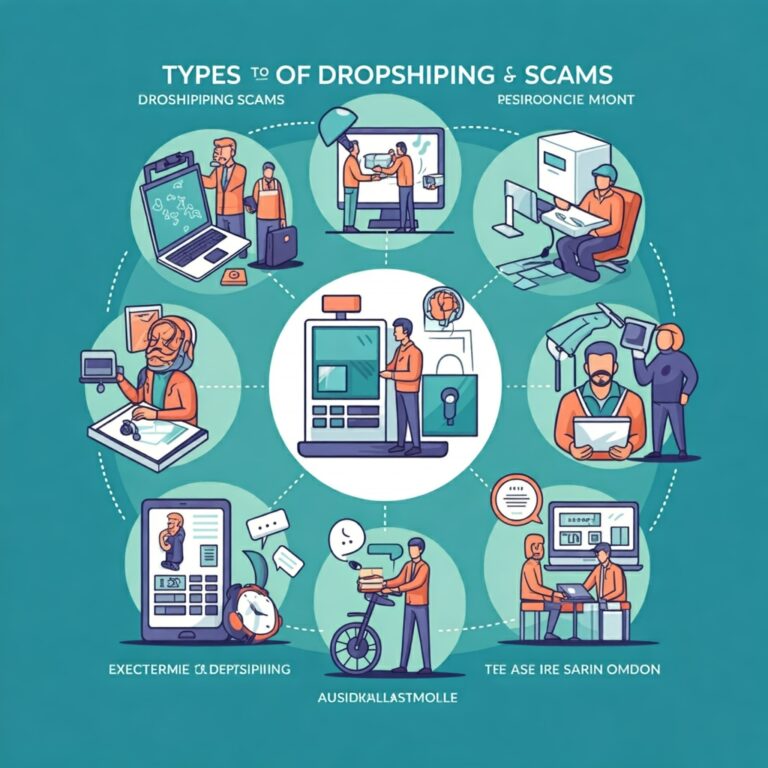Dropshipping has become a popular business model in recent years, as it allows individuals to sell products online without having to hold inventory or manage shipping logistics. While there are many legitimate dropshipping companies out there, unfortunately, there are also many dropshipping scams that can cause serious financial harm to unsuspecting entrepreneurs. In this article, we’ll discuss the different types of dropshipping scams, how to prevent them, and what to do if you become a victim.
Types of Dropshipping Scams
Fake Suppliers
Fake suppliers are a common type of dropshipping scam that can cause serious financial harm to unsuspecting entrepreneurs. These scammers create fake websites or social media profiles pretending to be legitimate suppliers, and may offer attractive deals or low prices on products. However, once you place an order and send payment, you may never receive the products or hear from them again. Here are some types of fake suppliers and tips on how to prevent falling victim to them:
- Fake Websites
One type of fake supplier scam involves fake websites. Scammers create websites that look like legitimate supplier websites, complete with product listings, pricing information, and contact information. However, once you place an order and send payment, you may never receive the products or hear from the supplier again.
To prevent falling victim to this type of scam, it’s important to do your research before making a purchase. Look for reviews or feedback from other customers, and check the supplier’s website for contact information such as a physical address or phone number. If the website looks suspicious or lacks contact information, it’s best to look for another supplier.
- Social Media Scams
Another type of fake supplier scam involves social media. Scammers create fake social media profiles pretending to be legitimate suppliers, and may post attractive deals or promotions to attract customers. However, once you place an order and send payment, you may never receive the products or hear from the supplier again.
To avoid falling victim to social media scams, always verify the supplier’s identity before making a purchase. Look for reviews or feedback from other customers, and check the supplier’s website for contact information. If the supplier only communicates through social media and refuses to provide any other contact information, it’s likely a scam.
- Middlemen Scams
Middlemen scams occur when a fake supplier poses as a legitimate supplier and charges higher prices for products. The fake supplier may take orders and payments from customers, but then source the products from a legitimate supplier for a lower price and keep the difference as profit. However, the products may be of lower quality or take longer to ship than advertised.
To avoid middlemen scams, it’s important to do your research and choose reputable suppliers with a proven track record of providing quality products and good customer service. Look for suppliers with a physical address, phone number, and responsive customer service team.
- Dropshipping Platforms
Another type of fake supplier scam involves dropshipping platforms. Some dropshipping platforms may advertise low prices on products, but then charge high fees or commissions that are not disclosed upfront. In some cases, the platform may even take orders and payments from customers, but fail to deliver the products or provide refunds.
To avoid dropshipping platform scams, always read the fine print and ask for a breakdown of all fees before signing up. Look for reviews or feedback from other sellers, and choose a platform with a good reputation and track record of providing good customer service.
Hidden Fees
Hidden fees are another common type of dropshipping scam that can cause financial harm to entrepreneurs. Some dropshippers may advertise low product prices, but then add on high shipping or handling fees that are not disclosed upfront. Here are some types of hidden fees and tips on how to prevent falling victim to them:
- Shipping and Handling Fees
One common type of hidden fee is shipping and handling fees. Some dropshippers may advertise free shipping, but then add on high handling fees or shipping surcharges that are not disclosed upfront. In some cases, these fees can even exceed the cost of the product itself.
To avoid falling victim to shipping and handling fees, always read the fine print and ask for a breakdown of all fees before making a purchase. Look for dropshippers that offer transparent pricing and clearly disclose all fees.
- Membership Fees
Another type of hidden fee is membership fees. Some dropshippers may require you to sign up for a membership or subscription to access their products, but then charge high fees or commissions that are not disclosed upfront. In some cases, these fees can be ongoing, and can quickly add up over time.
To avoid membership fee scams, always read the terms and conditions carefully before signing up for a membership or subscription. Look for dropshippers that offer flexible payment options and do not require you to sign up for long-term commitments.
- Currency Conversion Fees
Some dropshippers may charge currency conversion fees when you make a purchase using a foreign currency. These fees can be hidden and may not be disclosed upfront, which can make it difficult to compare prices across different dropshippers.
To avoid currency conversion fees, always check the exchange rate and ask for a breakdown of all fees before making a purchase. Consider using a payment method that offers competitive exchange rates and low currency conversion fees.
- Payment Processing Fees
Finally, some dropshippers may charge payment processing fees when you make a purchase using certain payment methods, such as credit cards or PayPal. These fees can be hidden and may not be disclosed upfront, which can make it difficult to compare prices across different dropshippers.
To avoid payment processing fees, always check the payment processing fees for different payment methods and ask for a breakdown of all fees before making a purchase. Consider using payment methods that offer low processing fees or cashback rewards.
Non-Delivery Scams
Non-delivery scams are a type of dropshipping scam that occurs when a dropshipper fails to send the products you ordered, even after you have paid for them. In some cases, the dropshipper may provide a fake tracking number or claim that the products were lost in transit. Here are some types of non-delivery scams and tips on how to prevent falling victim to them:
- Fake Tracking Numbers
One type of non-delivery scam involves fake tracking numbers. Some dropshippers may provide a tracking number that is not valid or is for a different shipment. This can make it difficult to track the shipment and determine if the products have been shipped or are still in transit.
To avoid falling victim to fake tracking numbers, always verify the tracking number with the carrier and check the shipment status regularly. If the shipment status does not update or there are discrepancies with the tracking information, contact the dropshipper immediately.
- Lost in Transit
Another type of non-delivery scam involves claims that the products were lost in transit. Some dropshippers may claim that the products were lost or stolen during shipping, and may offer a refund or replacement. However, in some cases, the dropshipper may not follow through on the refund or replacement, leaving you without the products or your money.
To avoid falling victim to lost in transit scams, always use a shipping method that includes tracking and insurance. This can help protect you in case the products are lost or damaged during shipping. If the dropshipper claims that the products were lost in transit, contact the carrier and file a claim for the lost or damaged products.
- Delayed Shipping
Finally, some dropshippers may delay shipping the products or provide false promises about the delivery date. This can be frustrating and can delay your business operations, especially if you are depending on the products for a specific event or deadline.
To avoid falling victim to delayed shipping scams, always ask for a shipping timeline and delivery estimate before making a purchase. Choose dropshippers that have a proven track record of delivering products on time and providing good customer service. If the products are delayed, contact the dropshipper and ask for a new delivery estimate.
In conclusion, non-delivery scams are a common type of dropshipping scam that can cause financial harm to entrepreneurs. To prevent falling victim to these scams, always verify tracking numbers, use a shipping method that includes tracking and insurance, and choose dropshippers that have a proven track record of delivering products on time and providing good customer service. By taking these steps, you can protect yourself from non-delivery scams and build a successful dropshipping business.
Preventing Dropshipping Scams
Do Your Research
The most important thing you can do to prevent dropshipping scams is to do your research. Before making a purchase from a new dropshipper, take the time to read reviews and feedback from other customers. Look for any red flags, such as a lack of contact information or negative reviews about non-delivery or hidden fees.
Choose Reputable Suppliers
When choosing a dropshipper, it’s important to choose a reputable supplier with a proven track record of delivering products on time and providing excellent customer service. Look for suppliers with a physical address, phone number, and a responsive customer service team.
Use Secure Payment Methods
To protect yourself from non-delivery scams, it’s important to use secure payment methods that offer buyer protection. PayPal and credit cards are two popular options that offer this type of protection.
Reporting Dropshipping Scams
If you become a victim of a dropshipping scam, it’s important to report it to the appropriate authorities. You can file a complaint with the Federal Trade Commission (FTC) or your local consumer protection agency. You can also report the scam to the Better Business Bureau (BBB) or the Internet Crime Complaint Center (IC3).
In addition to reporting the scam, you should also take steps to protect yourself from further harm. This may include canceling any orders or subscriptions with the scammer, changing your passwords and financial information, and monitoring your credit report for any suspicious activity.
Conclusion
While dropshipping can be a great way to start an online business, it’s important to be aware of the different types of scams that exist. By doing your research, choosing reputable suppliers, and using secure payment methods, you can protect yourself from these scams and build a successful dropshipping business. If you do become a victim of a dropshipping scam, make sure to report it and take steps to protect yourself from further harm.
















